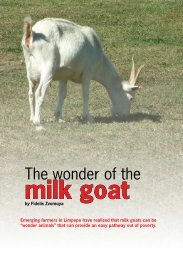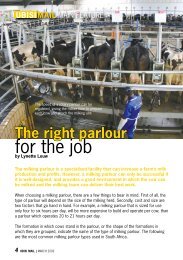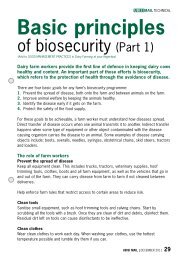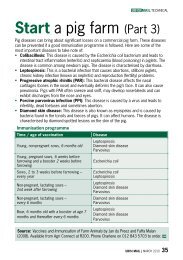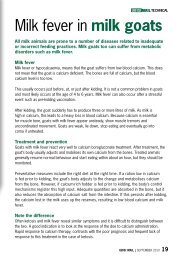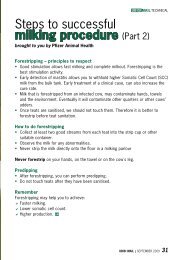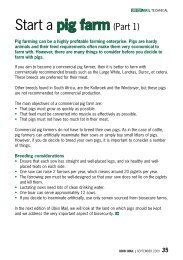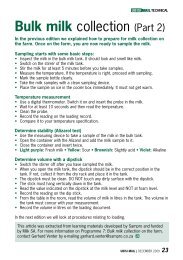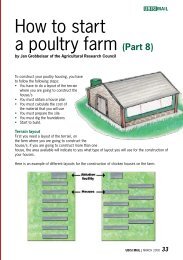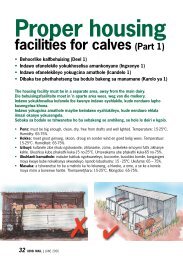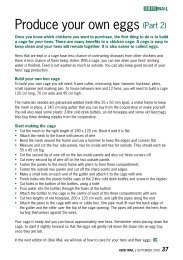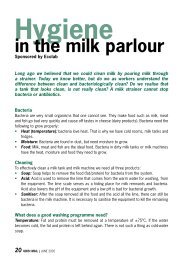Anaplasmosis - Ubisi Mail Magazine
Anaplasmosis - Ubisi Mail Magazine
Anaplasmosis - Ubisi Mail Magazine
You also want an ePaper? Increase the reach of your titles
YUMPU automatically turns print PDFs into web optimized ePapers that Google loves.
<strong>Anaplasmosis</strong><br />
by Dr Jan du Preez<br />
<strong>Anaplasmosis</strong> is a very serious disease of cattle and is<br />
transmitted through the bites of male blue ticks. The<br />
disease can be controlled by regularly vaccinating<br />
your cattle. <strong>Anaplasmosis</strong> is also<br />
known as gallsickness.<br />
<strong>Anaplasmosis</strong> occurs throughout the most parts of Southern<br />
Africa and Namibia, except in very low rainfall areas. Normally<br />
anaplasmosis is transmitted by at least five tick species namely the blue<br />
tick, the red-legged tick, the bont-legged tick, and other types. However,<br />
the male blue tick is regarded as the most important carrier of the infection.<br />
When are animals infected?<br />
Ticks pick up the infection when they feed on infected cattle or cattle that have recovered, but are still<br />
carriers of the parasite. Transport can also play a role when animals with the infection are moved to<br />
other areas.<br />
The weather can also play a role. Outbreaks are more common in the warm summer and autumn<br />
months when large amounts of ticks are found. There is also an increase in blood-sucking flies in<br />
these seasons.<br />
All cattle that have not been vaccinated, can contract the disease. However, all calves are born<br />
with a natural resistance to the disease. This natural resistance is best between 6 and 9 months.<br />
<strong>Anaplasmosis</strong> is much more serious in older animals. It may take between four to six weeks before an<br />
animal shows any sign of illness.<br />
Symptoms of anaplasmosis<br />
• A temperature increase<br />
• Anaemia (the eyes and tongue are pale)<br />
• Jaundice (the eyes are yellow)<br />
• Slowed or stopped rumination<br />
• Constipation<br />
• Dairy cows may show a drop in milk production and this is often the very first sign of infection.<br />
Treatment<br />
A veterinarian will make a diagnosis by taking a blood smear. He will give the animal a treatment of<br />
antibiotics or cortisone. But you can do the following to help the sick animal:<br />
• Do not move or transport the animal unnecessarily<br />
• Give the animal good quality fresh water<br />
• Give a mixture of sugar and vinegar or other stomach drugs to improve stomach function. UM<br />
UBISI MAIL | DECEMBER 2007 23
<strong>Anaplasmosis</strong><br />
• Anaplasmose<br />
• I-<strong>Anaplasmosis</strong><br />
• I-<strong>Anaplasmosis</strong><br />
• Lefu la matsetse (anaplasmosis)<br />
• The disease gets spread when male ticks feed on an infected<br />
animal and then move to another animal. Sometimes blood-sucking<br />
stable flies and horse flies carry infected blood in their mouths.<br />
• Die siekte word versprei wanneer manlike bosluise aan ‘n dier met die infeksie<br />
suig. Die bosluis beweeg dan na ‘n ander dier. Soms dra bloedsuiende vlieë<br />
en perdevlieë ook bloed met die infeksie in hulle monde.<br />
• Lesi sifo sisabalala uma ngabe imikhaza yesilisa incela isilwane esinesifo bese<br />
iyasuka iya kwesine isilwane. Ngezinye izikhathi izimpukane ezincela igazi ezihlala<br />
esitebeleni kanye nezimpukane zamahhashi zithwala igazi elinesifo ngemilomo yazo.<br />
• Isifo sisasazeka xa amakhalane aziinkunzi esitya kwisilwanyane esosulelekileyo aze ke asuke aye<br />
kwesinye isilwanyana. Ngamanye amaxesha iimpukane ezifunxa igazi esitalini kunye neempukane<br />
zamahashe ziye ziphathe ngemilomo yazo igazi elisulelekileyo.<br />
• Lefu lena le nama nakong eo matsetse a matona a iphepang phoofolong e nang le tshwaetso<br />
ebe a fetela phoofolong e nngwe. Ka dinako tse ding dintsi tse nwang madi setaleng sa dipere le<br />
diboba di jara madi a nang le tshwaetso hanong la tsona.<br />
• When? During the warmer summer and autumn months. When animals are moved to another area.<br />
• Wanneer? In die warmer somer- en herfsmaande. Wanneer diere na ‘n ander gebied verskuif word.<br />
• Nini? Ngezinyanga ezifudumele zasehlobo kanye nezasekwindla. Uma izilwane zisiwa kwenye indawo.<br />
• Nini? Ngexa leenyanga ezishushu zasehlotyeni nasekwindla. Xa izilwanyana zisisiwa komnye ummandla.<br />
• Neng? Nakong ya dikgwedi tse futhumetseng tsa lehlabula le lehwetla. Nakong eo diphoofolo di<br />
iswang sebakeng se seng.<br />
Symptoms<br />
• Fever<br />
• Anaemia (eyes and tongue are pale)<br />
• Jaundice (eyes are yellow)<br />
• Constipation<br />
• Drop in milk production<br />
Siektetekens<br />
• Koors<br />
• Bloedarmoede (die oë en tong is bleek)<br />
• Geelsig (die oë is geel)<br />
• Hardlywigheid<br />
• Laer melkproduksie<br />
24 UBISI MAIL | DECEMBER 2007
Izimpawu<br />
• Imfiva<br />
• I-anemiya (amehlo kanye nolimi kuphaphathekile)<br />
• Ijondisi (amehlo aphuzi)<br />
• Ukuqumba<br />
• Ukwehla ekukhiqizweni kobisi<br />
Iimpawu<br />
• Umkhuhlane<br />
• I-Anemia (amehlo nolwimi ziyafiphala)<br />
• Isifo senyongo (amehlo aba qanda)<br />
• Ukuqhineka<br />
• UKwehla ekuvelisweni kobisi<br />
Matshwao a Lefu<br />
• Feberu (motjheso)<br />
• Leqeme la disele tse kgubedu tsa madi (ho sehlefala ha madi le leleme)<br />
• Jaundice (mahlo a mmala o mosehla)<br />
• Ho pipitlelwa<br />
• Ho theoha ha tlhahiso ya lebese<br />
• Treatment: Give antibiotics, fresh water and a mixture<br />
of sugar and vinegar.<br />
• Behandeling: Gee antibiotika, vars water en ’n<br />
mengsel van suiker en asyn.<br />
• Ukwelapha: Nikeza ama-antibhayothiki, amanzi<br />
amasha kanye nengxube kashukela noviniga.<br />
• Unyango: Yinike izibulala-ntsholongwane, amanzi<br />
acocekileyo kunye nomxube weswekile neviniga.<br />
• Kalafo: Fana ka meriana e lwantshang dihlasela-mmele (antibiotics),<br />
metsi a hlwekileng le metswako wa tswekere le asene.<br />
• Prevention: Vaccinate your cattle regularly.<br />
• Voorkoming: Immuniseer jou beeste gereeld.<br />
• Ukuvimbela: Goma izinkomo zakho ngokuvamile.<br />
• Uthintelo: Gonya iinkomo zakho rhoqo.<br />
• Thibelo: Enta dikgomo tsa hao ka dinako tsohle. UM<br />
UBISI MAIL | DECEMBER 2007 25




